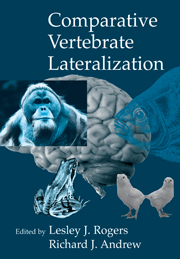Book contents
- Frontmatter
- Contents
- List of Contributors
- Preface
- Introduction
- Part one Evolution of lateralization
- 1 How ancient is brain lateralization?
- 2 The earliest origins and subsequent evolution of lateralization
- 3 The nature of lateralization in tetrapods
- 4 Advantages and disadvantages of lateralization
- Part two Development of lateralization
- Part three Cognition and lateralization
- Part four Lateralization and memory
- Epilogue
- Author Index
- Subject Index
- Richard Andrew
4 - Advantages and disadvantages of lateralization
Published online by Cambridge University Press: 10 December 2009
- Frontmatter
- Contents
- List of Contributors
- Preface
- Introduction
- Part one Evolution of lateralization
- 1 How ancient is brain lateralization?
- 2 The earliest origins and subsequent evolution of lateralization
- 3 The nature of lateralization in tetrapods
- 4 Advantages and disadvantages of lateralization
- Part two Development of lateralization
- Part three Cognition and lateralization
- Part four Lateralization and memory
- Epilogue
- Author Index
- Subject Index
- Richard Andrew
Summary
The first evidence of lateralization of visual function in a non-human species came from a study of the domestic chick (Rogers and Anson, 1979). At the time it was reported, it was met by disbelief on the grounds that lateralized responses to stimuli on the animal's left and right sides would surely be so disadvantageous that such a characteristic would never have evolved. Although it is now known that visual lateralization is present in a broad range of vertebrate species (as discussed in the preceding chapters), the selective advantages of being so lateralized have yet to be established convincingly. The aim of this chapter is to consider the possible advantages and disadvantages of being lateralized, and to do so in a number of species.
Disadvantages of Lateralization
It is not difficult to see the disadvantages of being lateralized for visual functions, provided they translate into side biases in latency or effectiveness of response, or even ignoring a particular stimulus when it is on one side and not the other. The first question to address, therefore, is whether differential specialization of the hemispheres does, in fact, lead to side biases.
Chapter 3 by Andrew and Rogers has outlined the differential specialization of the left hemisphere (LHem) to control responses directed toward prey and other food objects, and of the right hemisphere (RHem) to control attack responses.
- Type
- Chapter
- Information
- Comparative Vertebrate Lateralization , pp. 126 - 154Publisher: Cambridge University PressPrint publication year: 2002
- 42
- Cited by



